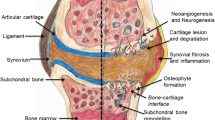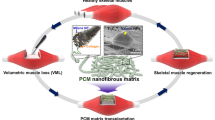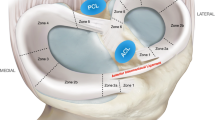Abstract
Trauma to the knee joint often results in injury to one or more supporting soft tissue structures, such as the medial collateral (MCL) and anterior cruciate (ACL) ligaments. Also, a portion of the patellar tendon (PT) is frequently used as a replacement graft for the ACL, resulting in a PT defect. The healing responses of these tissues are dramatically different and range from spontaneous healing to little or no healing. Studies have suggested that native cell behavior could be responsible for differences in healing potential. However, it is difficult to make comparisons as the reported results are based on different cellular passages which could have a dramatic effect on their potential to form healing tissues. Therefore, the objective of this study was to quantify the gene expression of collagen and other matrix constituents of fibroblasts from the MCL, ACL, and PT to document how they change with cell passage. We hypothesized that MCL fibroblasts would possess higher potential for matrix production through passages than ACL and PT cells because the MCL mounts a robust healing response unlike the ACL and PT. These differences in matrix expression would be dependent on passage because at earlier passages all cells would mostly be proliferating while at later passages they would tend to become senescent. Cells were isolated from the MCL, ACL, and PT of three rats and passaged a total of five times (Passage 1 to Passage 5). Using real time RT-PCR, expression of all genes of interest (Collagen Type I (ligament/tendon’s main matrix constituent), Collagen Type III, Fibronectin, Metalloprotease-13 [MMP-13], and Tissue Inhibitor of Metallopreotease-1 [TIMP-1]) were quantitatively assessed. It was found that cell number for all three fibroblast types remained high from Passage 1 to Passage 5. There was a statistically significant increase in Collagen Type I of rat MCL fibroblasts throughout passage (p < 0.05). This was evident in the higher relative abundance (to GAPDH) at Passages 3 and 4 (14.5 ± 2.2 fold and 15.3 ± 6.9 fold, respectively) than at Passage 1 (3.3 ± 2.6 fold) (p < 0.05). On the other hand, Collagen Type I expression for ACL and PT fibroblasts were lower than that of MCL fibroblasts and remained at 2.5 ± 2.0 fold and 1.7 ± 0.8 fold, respectively. Interestingly, the gene expressions of Collagen Type III, Fibronectin, MMP-13, and TIMP-1 for MCL, ACL, and PT fibroblasts were all relatively constant throughout passage and were not significantly different from one another. The findings of this study indicate that passage does affect the Collagen Type I gene expression of rat MCL fibroblasts and further show that for in vitro ligament tissue engineering efforts, MCL fibroblasts have a more robust potential for ligament remodeling and repair due to the increase in collagen gene expression.


Similar content being viewed by others
References
Awad H. A., Boivin G. P., Dressler M. R., Smith F. N., Young R. G., Butler D. L. 2003. Repair of patellar tendon injuries using a cell-collagen composite. J. Orthop. Res. 21: 420–431. doi:10.1016/S0736-0266(02)00163-8
Darling E. M., Athanasiou K. A. 2005. Rapid phenotypic changes in passaged articular chondrocyte subpopulations. J. Orthop. Res. 23: 425–432. doi:10.1016/j.orthres.2004.08.008
Ferretti, M., S. Madhavan, J. Deschner, B. Rath-Deschner, E. Wypasek, and S. Agarwal. Dynamic biophysical strain modulates proinflammatory gene induction in meniscal fibrochondrocytes. Am. J. Physiol. Cell Physiol. 290:C1610–C1615, 2006. doi10.1152/ajpcell.00529.2005
Fetto, J. F., and J. L. Marshall. The natural history and diagnosis of anterior cruciate ligament insufficiency. Am. J. Physiol. Cell Physiol. 147:29–38, 1980
Frank C., Woo S. L-Y., Amiel D., Harwood F., Gomez M., Akeson W. 1983. Medial collateral ligament healing. A multidisciplinary assessment in rabbits. Am. J. Sport Med. 11: 379–389. doi:10.1177/036354658301100602
Hanaoka, K., E. Tanaka, T. Takata, M. Miyauchi, J. Aoyama, N. Kawai, D. A. Dalla-Bona, E. Yamano, and K. Tanne. Platelet-derived growth factor enhances proliferation and matrix synthesis of temporomandibular joint disc-derived cells. Angle Orthod. 76(3):486–492, 2006
Hannafin J. A., Attia E. A., Henshaw R., Warren R. F., Bhargava M. M. 2006. Effect of cyclic strain and plating matrix on cell proliferation and integrin expression by ligament fibroblasts. J. Orthop. Res. 24: 149–158. doi:10.1002/jor.20018
Indelicato P. A. 1983. Non-operative treatment of complete tears of the medial collateral ligament of the knee. J. Bone Joint Surg. Am. 65: 323–329
Kobayashi K., Healey R. M., Sah R. L., Clark J. J., Tu B. P. et al. 2000. Novel method for the quantitative assessment of cell migration: a study on the motility of rabbit anterior cruciate (ACL) and medial collateral ligament (MCL) cells. Tissue Eng. 6: 29–38. doi:10.1089/107632700320865
Marui T., Niyibizi C., Georgescu H. I., Cao M., Kavalkovich K. W. et al. 1997. Effect of growth factors on matrix synthesis by ligament fibroblasts. J. Orthop. Res. 15: 18–23. doi:10.1002/jor.1100150104
Murray M. M., Martin S. D., Martin T. L., Spector M. 2000. Histological changes in the human anterior cruciate ligament after rupture. J. Bone Joint. Surg. Am. 82-A: 1387–1397
Musahl V., Abramowitch S. D., Gilbert T. W., Tsuda E., Wang J. H. et al. 2004. The use of porcine small intestinal submucosa to enhance the healing of the medial collateral ligament—a functional tissue engineering study in rabbits. J. Orthop. Res. 22: 214–220. doi:10.1016/S0736-0266(03)00163-3
Nagai, Y., K. Miyata, G.-P. Sun, M. Rahman, S. Kimura, A. Miyatake, H. Kiyomoto, M. Kohno, Y. Abe, M. Yoshizumi, and A. Nishiyama. Aldosterone stimulates collagen gene expression and synthesis via activation of ERK1/2 in rat renal fibroblasts. Hypertension 46(part 2):1039–1045, 2005
Nagineni C. N., Amiel D., Green M. H., Berchuck M., Akeson W. H. 1992. Characterization of the intrinsic properties of the anterior cruciate and medial collateral ligament cells: an in vitro cell culture study. J. Orthop. Res. 10: 465–475. doi:10.1002/jor.1100100402
Sachs R. A., Daniel D. M., Stone M. L., Garfein R. F. 1989. Patellofemoral problems after anterior cruciate ligament reconstruction. Am. J. Sport Med. 17: 760–765. doi:10.1177/036354658901700606
Song, W. W., and A. Ergul. Type-2 diabetes-induced changes in vascular extracellular matrix gene expression: relation to vessel size. Cardiovas. Diab. 5:3, 2006
Wiig M. E., Amiel D., Ivarsson M., Nagineni C. N., Wallace C. D., Arfors K. E. 1991. Type I procollagen gene expression in normal and early healing of the medial collateral and anterior cruciate ligaments in rabbits: an in situ hybridization study. J. Orthop. Res. 9: 374–382. doi:10.1002/jor.1100090309
Yao L., Bestwick C. S., Bestwick L. A., Maffulli N., Aspden R. M. 2006. Phenotypic drift in human tenocyte culture. Tissue Eng. 12: 1843–1849. doi:10.1089/ten.2006.12.1843
Acknowledgments
This study is supported in part by NIH grant #AR41820 and the NSF Graduate Research Fellowship.
Author information
Authors and Affiliations
Corresponding author
Rights and permissions
About this article
Cite this article
Almarza, A.J., Augustine, S.M. & Woo, S.LY. Changes in Gene Expression of Matrix Constituents with Respect to Passage of Ligament and Tendon Fibroblasts. Ann Biomed Eng 36, 1927–1933 (2008). https://doi.org/10.1007/s10439-008-9565-1
Received:
Accepted:
Published:
Issue Date:
DOI: https://doi.org/10.1007/s10439-008-9565-1




